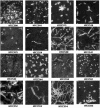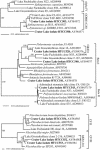Representative freshwater bacterioplankton isolated from Crater Lake, Oregon
- PMID: 15528517
- PMCID: PMC525233
- DOI: 10.1128/AEM.70.11.6542-6550.2004
Representative freshwater bacterioplankton isolated from Crater Lake, Oregon
Abstract
High-throughput culturing (HTC) methods that rely on dilution to extinction in very-low-nutrient media were used to obtain bacterial isolates from Crater Lake, Oregon. 16S rRNA sequence determination and phylogenetic reconstruction were used to determine the potential ecological significance of isolated bacteria, both in Crater Lake and globally. Fifty-five Crater Lake isolates yielded 16 different 16S rRNA gene sequences. Thirty of 55 (55%) Crater Lake isolates had 16S rRNA gene sequences with 97% or greater similarity to sequences recovered previously from Crater Lake 16S rRNA gene clone libraries. Furthermore, 36 of 55 (65%) Crater Lake isolates were found to be members of widely distributed freshwater groups. These results confirm that HTC is a significant improvement over traditional isolation techniques that tend to enrich for microorganisms that do not predominate in their environment and rarely correlate with 16S rRNA gene clone library sequences. Although all isolates were obtained under dark, heterotrophic growth conditions, 2 of the 16 different groups showed evidence of photosynthetic capability as assessed by the presence of puf operon sequences, suggesting that photoheterotrophy may be a significant process in this oligotrophic, freshwater habitat.
Figures



References
Publication types
MeSH terms
Substances
Associated data
- Actions
- Actions
- Actions
- Actions
- Actions
- Actions
- Actions
- Actions
- Actions
- Actions
- Actions
- Actions
- Actions
- Actions
- Actions
- Actions
- Actions
- Actions
- Actions
LinkOut - more resources
Full Text Sources
Other Literature Sources
Molecular Biology Databases

